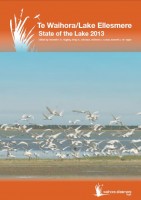2013 State of the Lake
Te Waihora/Lake Ellesmere: State of the Lake 2013 – download it here
 WET launched a new publication at the fourth Living Lake Symposium, held at Lincoln University on November 7 and 8, 2013. Focusing on sets of indicators for a range of different topics, several short reports by expert authors have been compiled to present an update on the state of the lake 2013.
WET launched a new publication at the fourth Living Lake Symposium, held at Lincoln University on November 7 and 8, 2013. Focusing on sets of indicators for a range of different topics, several short reports by expert authors have been compiled to present an update on the state of the lake 2013.
More information – scroll down to find further reports and links on particular topics.
Please note, Environment Canterbury began updating their website in late 2016 and have removed or changed links to a number of the documents listed below. If a link for an ECan document or webpage no longer works, please contact ECan directly and they may be able to help you.
Selwyn Waihora
Environment Canterbury, as part of their sub-regional planning process for Selwyn-Waihora, have gathered together a large number of reports and presentations on a wide range of topics. The page can be accessed here and is well worth a visit.
The State of the Lake 2013 report includes an introduction and nine sections covering different topics. Additional reports and links for each topic have been added below, with some more information still to come for some topics.
1. Introduction
Background information about the Lake can be found in The State of the Lake, Hughey et al, (2008). The individual chapters can be downloaded from the page on this website.
There are various sources of additional information, including Stephen Kitto’s 2010 MSc Thesis on the Environmental History of Te Waihora/Lake Ellesmere.
In order to select indicators to report on, first we asked “how will we know when we have achieved success?” In the State of the Lake 2013 report a table of desired outcomes for the Lake and associated values is included. This is derived from a range of planning and policy documents. For a full explanation please see the ‘Summary document’ prepared by WET in mid 2013.
2. Governance and Management
The relationships between the different groups involved in governance and management around Te Waihora is very complex. A diagram was created in 2013 to represent some of these relationships and the agreements that are in place. This was presented as part of the 2013 Living Lake Symposium and can be seen here.
Links for some of the key plan, policies and agreements:
- Whakaora Te Waihora Co-governance Agreement
- Whakaora Te Waihora Joint Cultural and Ecological Restoration Plan
- Mahaanui Iwi Management Plan 2013 (IMP)
- Lake opening consent
- Te Waihora Joint Management Plan
- Flood Protection & Drainage Bylaw
- Proposed Land & Water Regional Plan
- Selwyn District Plan
- Christchurch City Plan
- National Environmental Standard for Sources of Human Drinking Water
3. Economy
Census 2013 data is available from Statistics NZ.
Selwyn District Quarterly Economic Monitor, March 2012 from Infometrics
An Economic Impact Assessment has been prepared for Environment Canterbury as part of the limit setting process for the Selwyn-Waihora catchment. Several scenarios have been considered and compared to the current situation.
4. Land use and Land cover
See information prepared as part of the Selwyn-Waihora sub-regional planning process.
5. Water
Swimming water quality at selected sites around Canterbury, including around the lake and at Coes and Chamberlains Fords, is available from the ECan website.
Te Waihora/Lake Ellesmere Catchment:Functional Significance and Sensitivity of Groundwater Fauna – report prepared for ECan, March 2013
The surface water resource of the Lake Ellesmere/Te Waihora catchment – Dan Clark, Environment Canterbury, July 2011
other information is also available on the Selwyn-Waihora sub-regional planning page.
6. Vegetation
‘Is the wetland vegetation outstanding?’ – Philippe’s Gerbeaux’s evidence for the Water Conservation Order hearing.
7. Wildlife
Information on the 2013 Te Waihora bird survey is available on our bird survey page.
A longer version of the summary included in the State of the Lake report is coming soon….
8. Fish
A background paper on the fish and fisheries of Te Waihora contributing to the 2013 State of the Lake report can be downloaded here.
The Department of Conservation has produced an information sheet on pest fish species.
Reports drawn on for the fisheries information included:
- Beentjes, M.P., Manning, M.J., 2010, Characterisation and CPUE analyses of the flatfish fishery in FLA 3. NIWA New Zealand Fisheries Assessment Report.
- Beentjes, M.P., Dunn, A., 2013, Catch per unit effort (CPUE) analyses and characterisation of the South Island commercial freshwater eel fishery, 1990–91 to 2009–10. New Zealand Fisheries Assessment Report 2013/11.
- Beentjes, M.P., 2013, Monitoring commercial eel fisheries: 2009–10 to 2011–12. New Zealand Fisheries Assessment Report 2013/47.
- Ministry for Primary Industries, Annual review of Freshwater Fisheries 2011/12, MPI Technical Paper 2013/15, July 2013.
Two relatively recent report from Don Jellyman (NIWA) are also useful resources: Fish Recruitment into Te Waihora/Lake Ellesmere (2012) and The importance of tributary streams of Te Waihora/Lake Ellesmere in maintaining populations of longfin eels (2010).
8. Recreation
A background paper on the state of Recreation at Te Waihora contributing to the 2013 State of the Lake report can be downloaded here.
DOC have a webpage with useful information on game bird hunting around Te Waihora/Lake Ellesmere
Brown trout spawning in the Lake Ellesmere (Te Waihora) tributaries, and some surrounding catchments – report prepared for Environment Canterbury, December 2006.
9. Cultural health
An expanded version of the Cultural Health summary prepared by Gail Tipa, which includes comments on how each grade has been derived, can be downloaded here.
The report Cultural values,flow &water management issues for the Waikirikiri/Selwyn -Te Waihora catchments, prepared by Tipa and Associates, 2013, for the Selwyn Waihora zone committee can be downloaded here.
